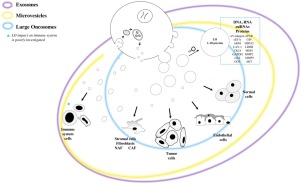当前位置:
X-MOL 学术
›
Cytokine Growth Factor Rev.
›
论文详情
Our official English website, www.x-mol.net, welcomes your feedback! (Note: you will need to create a separate account there.)
Large extracellular vesicles: Size matters in tumor progression.
Cytokine & Growth Factor Reviews ( IF 13.0 ) Pub Date : 2019-12-31 , DOI: 10.1016/j.cytogfr.2019.12.007 Chiara Ciardiello 1 , Rossella Migliorino 1 , Alessandra Leone 1 , Alfredo Budillon 1
Cytokine & Growth Factor Reviews ( IF 13.0 ) Pub Date : 2019-12-31 , DOI: 10.1016/j.cytogfr.2019.12.007 Chiara Ciardiello 1 , Rossella Migliorino 1 , Alessandra Leone 1 , Alfredo Budillon 1
Affiliation

|
Extracellular Vesicles (EVs) represent a heterogeneous population of particles naturally released from all cells, delimited by a lipid bilayer and able to horizontally transfer their cargos to recipient cells. These features imply the growing interest on EVs in cancer biology as biomarkers and therapeutic targets. In this review, we will highlight the specific process related to biogenesis and release of large EVs (L-EVs) derived from the plasma membrane (PM) compared to the small and well described exosomes, generated through the classical endosome-multivesicular body (MVB) pathway. The control of PM rigidity by cells depends on lipid/protein composition, cytoskeleton dynamics, cytoplasmic viscosity, ions balance, metabolic reprogramming and specific intracellular signaling pathways, all critical determinants of L-EVs biogenesis. We will focus in details on a specific class of L-EVs, named Large Oncosomes (LO), exclusively shed by cancer cells and with a size ranging from 1 μm up to 10 μm. We will examine LO specific cargos, either proteins or nucleic acids (i.e. mRNA, microRNAs, single/double-stranded DNA), as well as their functional role in cancer development and progression, also discussing the mechanisms of L-EVs internalization by recipient cells. Overall we will highlight the potential of LO as specific diagnostic/prognostic cancer biomarkers discussing the associated challenges.
中文翻译:

大的细胞外囊泡:大小与肿瘤的进展有关。
细胞外囊泡(EVs)代表从所有细胞自然释放的异质粒子群,由脂质双层限定,并能够将其货物水平转移到受体细胞。这些特征表明电动汽车在癌症生物学中作为生物标志物和治疗靶标的兴趣日益浓厚。在这篇综述中,我们将重点介绍与通过经典的内体-多囊泡体(MVB)产生的小型且描述充分的外泌体相比,源自质膜(PM)的大型EV(L-EV)的生物发生和释放的具体过程。 )途径。细胞对PM刚性的控制取决于脂质/蛋白质组成,细胞骨架动力学,细胞质粘度,离子平衡,代谢重编程和特定的细胞内信号传导途径,这些都是L-EVs生物发生的关键决定因素。我们将详细介绍特定类别的L-EV,称为大型癌体(LO),其大小仅由癌细胞脱落,大小从1μm到10μm不等。我们将研究LO特有的货物,无论是蛋白质还是核酸(即mRNA,microRNA,单链/双链DNA),以及它们在癌症发生和发展中的功能,还讨论了受体细胞将L-EV内在化的机制。总体而言,我们将着重介绍LO作为讨论相关挑战的特定诊断/预后癌症生物标志物的潜力。以及它们在癌症发展和进展中的功能作用,还讨论了受体细胞将L-EV内在化的机制。总体而言,我们将着重介绍LO作为讨论相关挑战的特定诊断/预后癌症生物标志物的潜力。以及它们在癌症发展和进展中的功能作用,还讨论了L-EV被受体细胞内在化的机制。总体而言,我们将着重介绍LO作为讨论相关挑战的特定诊断/预后癌症生物标志物的潜力。
更新日期:2019-12-31
中文翻译:

大的细胞外囊泡:大小与肿瘤的进展有关。
细胞外囊泡(EVs)代表从所有细胞自然释放的异质粒子群,由脂质双层限定,并能够将其货物水平转移到受体细胞。这些特征表明电动汽车在癌症生物学中作为生物标志物和治疗靶标的兴趣日益浓厚。在这篇综述中,我们将重点介绍与通过经典的内体-多囊泡体(MVB)产生的小型且描述充分的外泌体相比,源自质膜(PM)的大型EV(L-EV)的生物发生和释放的具体过程。 )途径。细胞对PM刚性的控制取决于脂质/蛋白质组成,细胞骨架动力学,细胞质粘度,离子平衡,代谢重编程和特定的细胞内信号传导途径,这些都是L-EVs生物发生的关键决定因素。我们将详细介绍特定类别的L-EV,称为大型癌体(LO),其大小仅由癌细胞脱落,大小从1μm到10μm不等。我们将研究LO特有的货物,无论是蛋白质还是核酸(即mRNA,microRNA,单链/双链DNA),以及它们在癌症发生和发展中的功能,还讨论了受体细胞将L-EV内在化的机制。总体而言,我们将着重介绍LO作为讨论相关挑战的特定诊断/预后癌症生物标志物的潜力。以及它们在癌症发展和进展中的功能作用,还讨论了受体细胞将L-EV内在化的机制。总体而言,我们将着重介绍LO作为讨论相关挑战的特定诊断/预后癌症生物标志物的潜力。以及它们在癌症发展和进展中的功能作用,还讨论了L-EV被受体细胞内在化的机制。总体而言,我们将着重介绍LO作为讨论相关挑战的特定诊断/预后癌症生物标志物的潜力。



























 京公网安备 11010802027423号
京公网安备 11010802027423号